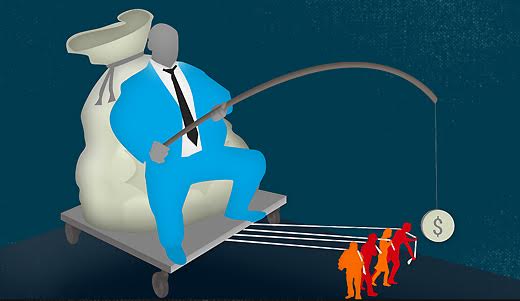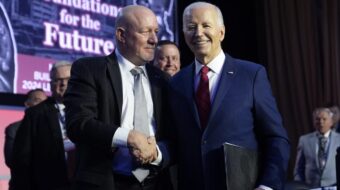
CHICAGO (PAI) – Michael Smith had a good middle-class job – or at least he did, until March 23.
Now thanks to the corporate greed of his company’s CEO, whose income of millions of dollars is detailed in the AFL-CIO’s newest edition of Executive Paywatch, the 59-year-old father of four doesn’t know where his next job will be. His production line was closed and moved to Mexico. And the prostate cancer survivor’s health insurance runs out next month.
Smith and 276 other workers at the Nabisco plant on Chicago’s Southwest Side, makers of Oreo cookies and other processed foods were, in so many words, fired that March day because company CEO Irene Rosenfeld wants to increase her $19.67 million annual compensation – and shareholders’ rewards. And 300 more workers may soon also be gone.
By contrast, Smith, a member of Bakery, Confectionery and Tobacco Workers and Grain Millers Local 300, which represents all the workers at the 1,800-person plant on South Kedzie Avenue, made $25.70 hourly last year, up about $6 hourly from when he began.
“We were comfortable, but we weren’t anywhere near Irene Rosenfeld’s level,” the father of four daughters says. And he got the bad news at the end of his 3 am shift.
Such contrasts lead the AFL-CIO to publish its yearly study comparing CEO pay and the median pay of U.S. workers. Based on federal data, the study reports the median CEO in 2015, or in some cases 2014, made 335 times what the median worker did, $36,875.
Rosenfeld’s pay and perks package was 534 times that of the median U.S. worker, but far below the top earner, Joe Kiani of Masimo Corp. He earned $119.2 million, almost all of it in stock options. The median is the point where half the group – CEOs and workers – are above and half below. The data is at www.paywatch.org.
Rosenfeld, who heads Mondelez, the conglomerate that now owns Nabisco, is just one member of a subset of CEOs the federation highlighted this year: Those who draw high pay, perks and insider stock options while moving well-paying U.S. jobs overseas.
Another is Gregory Hayes of United Technologies, parent of Carrier Corp. He earned $24 million last year, the figures show. This spring, he closed the Carrier furnace plant outside of Indianapolis, shifting its 1,400 jobs away from Steelworkers there to Mexico.
And they’re joined by Lowell McAdam, Verizon’s CEO. His corporation earned billions of dollars in profits in the last three years, and he earned $18.34 million last year. But after nine months of fruitless talks – in which Verizon refused to budge from cost-cutting that would double workers’ health care costs and give the company unlimited freedom to move call center jobs to Mexico and the Philippines – its 39,000 unionists, members of the Communications Workers and the Electrical Workers, were forced to strike a month ago.
And it’s not just high executive pay that tilts the playing field against workers, says Heather Corzo, the AFL-CIO’s lead analyst of the Paywatch data. Nabisco/Mondelez has $19.2 billion “in un-repatriated profits,” stashed overseas to escape U.S. taxes.
It can do that “due to one of the tax loopholes that also encourage corporations to ship U.S. jobs overseas,” she adds.
Ironically, the outsized CEO pay packages are not the largest in the private sector. That honor goes to hedge fund managers. Reuters reported during the week of May 13 that the top 25 hedge fund managers – who spend their time in wheeling and dealing and massive trading, moving money around – had average compensation of around $1 billion each last year.
Considering the hedge fund managers don’t even supervise creation of any tangible goods, “That’s even more egregious,” than CEO pay outrages, the AFL-CIO’s Corzo adds.
Organized labor is supporting solutions to curb such giant corporate giveaways. One is a financial transactions tax, a top cause of AFL-CIO member union National Nurses United.
That small tax on each securities trade-by hedge fund managers, corporate CEOs and others-would raise an estimated $360 billion yearly to help close the federal budget deficit and fund human needs and infrastructure projects, NNU adds. It could also curb the speculative, frenzied trading that helped lead to the Great Recession.
Another solution is close yet another corporate tax loophole that gives firms federal tax deductions for “performance pay” to executives.
And a third is to eliminate another big benefit for hedge fund managers, the so-called “carried interest” loophole, where income the traders gain from their deals are taxed at the low capital funds tax rate, not higher income tax rates.
But the fed faces an uphill battle in getting those reforms enacted, and even then they might not solve the entire executive pay problem, Corzo admits.
“I don’t think there is any single fix. And right now, power is concentrated in the hands of corporate CEOs,” she says.
In the meantime, Smith and his 276 fellow laid-off BCTGM colleagues wait, worry and hope. Their local is negotiating with Nabisco/Mondelez about terms of the firm’s exit from the South Side. “In all honesty, the tension and the pressure on us is unbelievable,” he says.
The Chicago workers hope outside pressure and publicity – including the paywatch figures and an AFL-CIO-called boycott of Mexico-made Oreo cookies – will create a company reversal. The Chicago production line was profitable, the union notes, but not as profitable as making Oreos in Mexico.
Photo: AFL-CIO Paywatch.org

MOST POPULAR TODAY

‘Warning! This product supports genocide’: Michigan group aims to educate consumers

Ohio: Franklin County treasurer attends Netanyahu meeting, steps up Israel Bond purchases

After months of denial, U.S. admits to running Ukraine biolabs

“Trail of Tears Walk” commemorates Native Americans’ forced removal

Hold the communism, please: SFMOMA’s Diego Rivera exhibit downplays artist’s radical politics






Comments